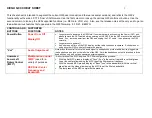
EMX Industries, Inc.
Tech support: 216-518-9889
1/2
WEL-200 Receiver Screw Terminal Block
Reference the image below for terminal numbers in step 4 - 7
WEL-200
™
Wireless Edge Link
QuickStart Guide
(RED PCB)
In this guide, the acronym RX refers to the WEL-200 Receiver,
and TX refers to the WEL-200 Transmitter.
Mounting the RX and TX
1.
Determine where the RX and TX will be located. Ensure there is direct line of sight (LOS) between the RX
and all TX install locations. The cable grip on all RX and TX devices must be facing down to prevent water
from entering the housing.
2.
Mount the RX to the exterior of the operator housing using four #8 machine screws. The mounting holes
can be found under the front cover. Have the
RX’s PCB
antenna extend at least 1 inch above the operator
housing to provide LOS to transmitters on the opposite side of the operator housing.
3.
Mount the TX near the edge sensor using two #8 machine screws. Wire the edge into the TX
’
s terminal
blocks. There is no polarity on this wiring.
Receiver Wiring
1.
All wiring to WEL-200 devices must pass
through the sealing cable grip to keep
the devices waterproof.
2.
Wire power from the operator to RX
terminals
11
&
12
.
The acceptable input voltage range is
12-24VDC/AC.
3.
On the RX board, set
DIP switches 1 through 4
to
“RELAY 1”
position. This will
make all four transmitter channels output through the
PULSE 1
and
RELAY 1
terminals. If more than one relay is required for the install (Open & Close Edges)
refer to the WEL-200 operating instructions.
4.
Determine the monitoring method the gate operator requires. The WEL-200 supports 10K and normally
closed monitoring, as well as 4-wire 300/0Hz pulsed outputs.
5.
For
10K monitoring,
wire operator common to terminal
6
, and the operator
safety input to terminal
7
. Place the 10K enable jumper into the bottom or
ON
position (see top photo on the right).
6.
For
NC monitoring,
wire operator common to terminal
6
, and the operator
safety input to terminal
5
. Place the 10K enable jumper into the top or
OFF
position (see bottom photo on the right).
7.
For
4-wire
300Hz/0Hz Pulsed monitoring,
wire the operator common to
terminal
1
and the operator safety input to terminal
2
.
TIP:




















